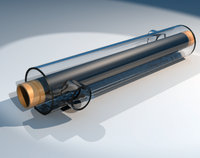
Photo from wikipedia
Abstract Heat exchanging is one of the critical process in a thermal system and requires in depth optimization of equipment configuration. In this study, the advantage of morphing the flow… Click to show full abstract
Abstract Heat exchanging is one of the critical process in a thermal system and requires in depth optimization of equipment configuration. In this study, the advantage of morphing the flow channel design to more complicated configuration is shown for the purpose of enhancing the flow and thermal characteristics of counterflow heat exchanger. The free pursuit for the optimal geometry of flow channel cross-sections will be investigated toward meeting two objectives simultaneously: lower longitudinal (along the flow direction) flow resistances and lower perpendicular (channel to channel) thermal resistance. For hexagonal, square, and triangular ducts, an analytical model is used to evaluate the fluid flow and heat transfer relative performances. The hexagonal array can be packed tightly without leaving spaces in between, such as in packing circular tubes. However, having inactive channels within the hexagonal bundle is one of the main challenges that reduce the thermal performance of counterflow heat exchanger. Thus, a hybrid packing of mixed configurations is considered in this paper for which a 3D numerical model (CFD) is used to analyze its thermal and fluid flow features. The findings reveal that the triangular array offers higher thermal performance as compared to that of the competitive arrays. However, when heating and flow effects are considered simultaneously, the hybrid array provides the improved performance among the other configurations considered.
Journal Title: International Communications in Heat and Mass Transfer
Year Published: 2021
Link to full text (if available)
Share on Social Media: Sign Up to like & get
recommendations!